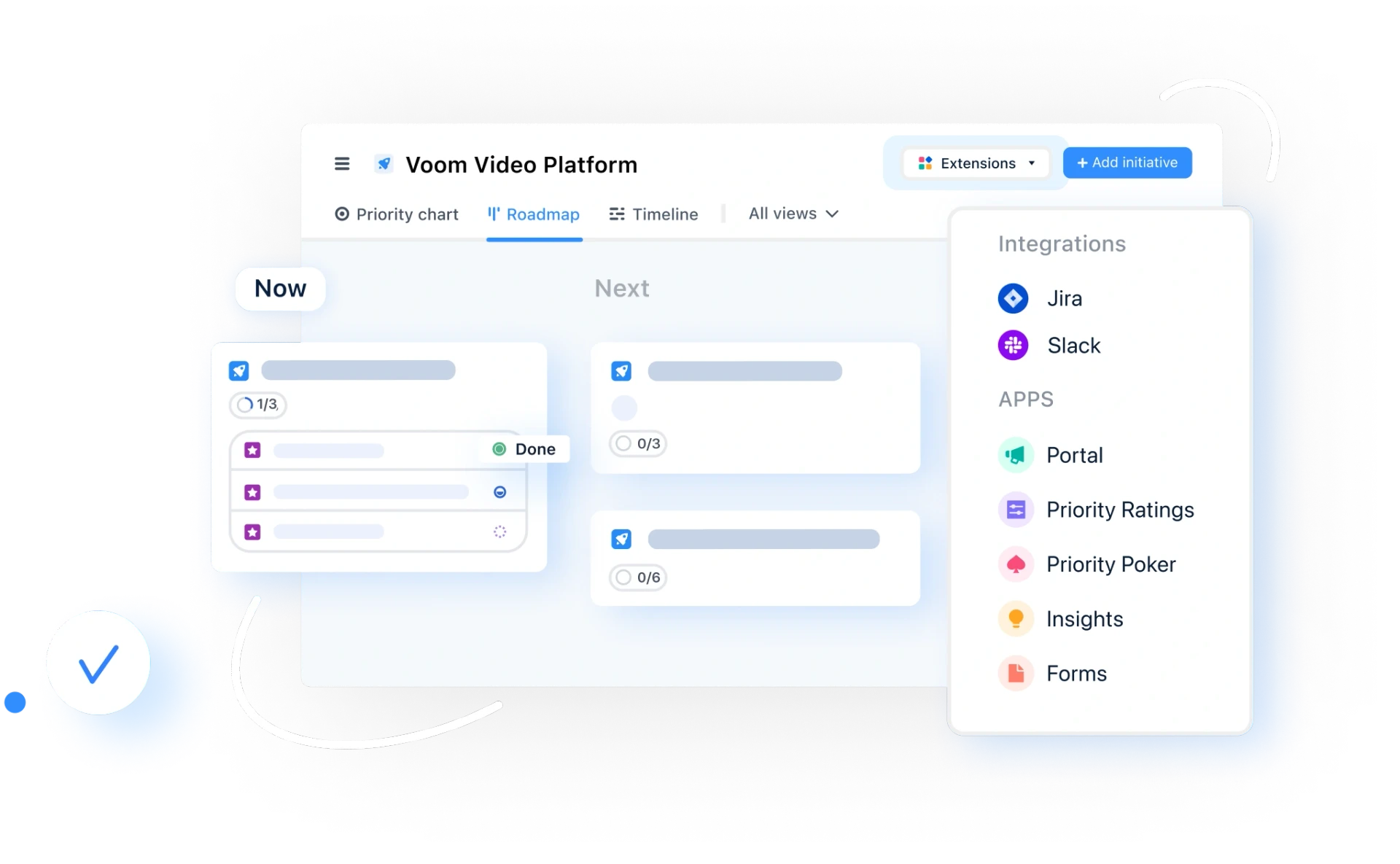Best product roadmap software in 2025: Key features & why airfocus stands out

As a product manager, startup founder, or key decision-maker, you’ll know how important planning is for achieving your goals. Releasing software or hardware to the market without a clear strategy introduces unnecessary risk—and there’s already more than enough of that to deal with.
That’s why developing a comprehensive roadmap and planning your workflows is paramount to success. This can be incredibly complex, though, especially for new businesses and teams working together for the first time.
Fortunately, the latest roadmap planning tools make it much easier. So, how do you find the best roadmap planner software on the market? And why is it so important for product and strategic planning anyway?
In this guide, we outline the benefits of great product roadmap software and the most helpful features to consider.
What is product roadmap software?
A Product roadmap software helps product managers plan work, track progress, coordinate activities, and ensure effective communication and collaboration between teams.
Roadmaps set out the high-level strategy behind a project and illustrate the expected progress during the development process.

How a product roadmap looks can differ tremendously, depending on the type of project, the intended audience, and the team using it.
Roadmaps for development teams, for example, tend to be shorter, snappier, and more ambitious, with multiple iterations and releases. Roadmaps for sales teams, on the other hand, focus far more strongly on the end benefits for users.
No matter who is using them, one thing is for sure: a product roadmap is one of the most important tools you have at your disposal.
A product roadmap keeps all stakeholders aligned, focusing on the right tasks at the right time.
That’s why the best product roadmap software will help you quickly illustrate the vision for your product and its development cycle — capturing and prioritizing all the necessary information in a way that feels motivating for the team.

More specifically, product roadmap software helps you organize milestones, goals, deadlines, resources, and more, bringing everything together in a clear, visual layout.
Crucially, great product roadmap software also allows the roadmap to be a dynamic, flexible document, adapting as a project develops by reacting to changes or issues encountered during the process.
Why roadmap software is essential for product & strategic planning
As seasoned product managers know, a roadmap is a critical addition to your arsenal when steering projects to success. It helps create a smoother process and avoid small issues that could negatively affect progress (or stop it dead).
Pros of using roadmap software for product & strategic planning
The best product roadmap software provides a high-level view of product direction and strategic initiatives, allowing teams to:
Align on priorities
Communicate plans to stakeholders
Adapt to changing needs down the line
Track progress at a glance
Not only can this reduce the risk of miscommunication, but it helps prevent mistakes and delays that could arise as a result. As product managers know, any disruptions to a product’s development and launch could affect its eventual success.
Cons of not using roadmap software for product & strategic planning
Teams that don’t use product roadmap software are likely to struggle with maintaining a long-term vision while managing short-term tasks. Common challenges of roadmap planning without dedicated roadmap planning tools include:
Lack of visibility into priorities across teams: Teams may be unable to identify priority tasks, track progress, and collaborate effectively.
Difficulty in adapting to market or internal changes: External and internal changes should be expected. Adapting to these fluctuations will likely be more difficult and time-consuming without product strategy software.
Manual effort required to update and communicate roadmap changes: Updating roadmaps and explaining any adjustments to different teams is much simpler with the best product management roadmap tools. You can automate tasks and streamline the planning process to free up time for essential jobs.
Misalignment between strategy and execution: Without a product roadmap, the work involved in developing a product may not reflect the initial strategy. This could lead to a disconnect from the original vision and make it harder to solve the customer’s pain points.
Using the best roadmap planner software available can help any business overcome these challenges and cultivate a harmonious development process.

Key features to look for in the best product roadmap software
Here are five features to watch out for when scouring the market for roadmap visualization tools:
Customizable roadmap views
Good strategic roadmap software provides different teams with different roadmapping formats, including:
Timeline
Kanban
Goal-driven/goal-oriented
Now-next-later
Providing the right roadmap format helps teams work effectively based on their preferred approach (e.g. Scrum, Dynamic Systems Development). With custom views, you can improve communication and ensure that each team sees the information most relevant to their tasks.
How airfocus helps
As the best product roadmap software, airfocus offers flexible roadmap templates and customizable views to align different stakeholders. Choose from a range of pre-built templates to save time or use the user-friendly roadmap builder to craft your own within minutes.
Sharing custom roadmaps with various views is easy, providing different teams and stakeholders with the visibility they need.
Prioritization & scoring integration
Prioritization frameworks help teams focus on high-impact goals without being distracted by lower-priority jobs. Clear prioritization can be tricky without good product strategy software, and choosing the right framework for your team will help you tackle the most critical tasks first.
Popular frameworks include:
RICE (Reach, Impact, Confidence, Effort): Teams consider these four factors to score ideas and decide whether to proceed or shelve them.
MoSCoW (Must-Have, Should-Have, Could-Have, Won’t-Have): Teams score ideas based on how essential they are to a product’s success.
Value vs. Effort: Teams use the simple Value vs. Effort framework to weigh the amount of work involved in realizing an idea against the potential benefits it’s likely to introduce.
These and other scoring systems enable data-driven decision-making. Teams can prioritize tasks based on collaborative discussions, past projects, and an understanding of the target market.
How airfocus helps
airfocus features built-in prioritization frameworks and scoring models to help teams evaluate opportunities objectively. Use custom scoring frameworks to drive decision-making and recognize the most valuable ideas. You can also avoid initiatives that waste time and use Priority Poker’s prioritization scores to improve alignment.
Collaboration & team alignment features
Roadmaps must be dynamic and allow input from multiple teams instead of being completely fixed from start to finish. Any new ideas that could contribute to a product’s value and eventual success must be accommodated with ease.
With real-time updates and feedback tools, stakeholders can stay aligned at all times, reducing the likelihood of oversights and miscommunications.
How airfocus helps
airfocus includes collaborative features such as Priority Poker and integrations with key collaborative software like Slack, Microsoft Teams, and Jira. Collect feedback from multiple channels (e.g. email, live chat) to better understand user needs and solve problems effectively.
Managing your Objectives and Key Results (OKRs) is quicker and simpler, too. Track progress and make sure daily work contributes to achieving overall goals.
AI-powered insights & automation
Today’s best roadmap planner software uses AI to provide greater insights and automation. AI can analyze historical decisions and suggest prioritization adjustments based on its findings. Automating roadmap updates helps save time and reduce the amount of manual work involved, creating a more productive team.
How airfocus helps
With airfocus’ AI Assist, enjoy AI-assisted backlog prioritization and automation tools. Use prompts for product managers, generate ideas, analyze feedback sentiment, and streamline workflows to work more efficiently than ever.
Seamless integrations with other tools
Roadmaps should sync with the project management and development tools you rely on daily, including Trello, Slack, Jira, and Asana. Integrating roadmaps with these tools ensures that cross-functional teams stay aligned without duplicating work. As a result, you can work smarter, not harder.
How airfocus helps
airfocus empowers teams to collaborate effortlessly thanks to its two-way syncing with Jira, Trello, and other popular platforms. With the airfocus-Jira integration, you can use strategic roadmap software for everything related to product management while maintaining existing development processes. And you have the power to monitor your progress from one place.
How airfocus excels as the best roadmap software for product & strategic planning
Here are four reasons why airfocus is the best product roadmap software:
Modular structure for a bespoke setup: airfocus is a modular platform that enables teams to customize their roadmap approach and build the best configuration for their preferred methodology.
Combining key functions: airfocus combines prioritization, collaboration, and visualization in a single tool for your convenience.
Extensive adaptability: airfocus is more adaptable than traditional roadmap planning tools, offering flexibility for different teams and industries.
Capable of transforming your approach: airfocus can help create a cleaner, more efficient planning process with transformational results. Case and point: Papirfly. They struggled with managing more than 30 products and 300+ services with multiple tools and an unclear approach to planning. But airfocus helped Papirfly streamline their product development and centralize their roadmap into one cohesive plan.

Choosing the right roadmap software for your team
The best roadmap planner software for your hard-working team can have a powerful impact on your efficiency, productivity, and (crucially) your results. Understanding the most important features to look out for will help you identify the right option for your team. These include:
Customization
Prioritization
Collaboration
AI insights
Integrations
The best product roadmap software should align with your product and business strategy instead of forcing you to change your entire methodology just to accommodate it.
Another key point is that roadmap visualization tools must support iterative changes without disrupting workflows. Making adjustments based on internal and external factors to keep everyone on the same page should be easy.
Get started with airfocus today
airfocus offers everything you need for comprehensive roadmapping, with AI tools for product managers, multiple integrations, and collaborative features to bring your team closer together. It’s easy to use and flexible, with extensive customization for a tailored configuration.
If you’re looking to build strategic roadmaps and keep teams on track from discovery to delivery, airfocus is the solution you need. Try our product roadmap software for yourself and book a demo today. Or read our product management case studies and find out what other airfocus users have to say!
How to build a product roadmap: the 5 best product roadmap software solutions...
airfocus — the only software to offer dedicated prioritization tools
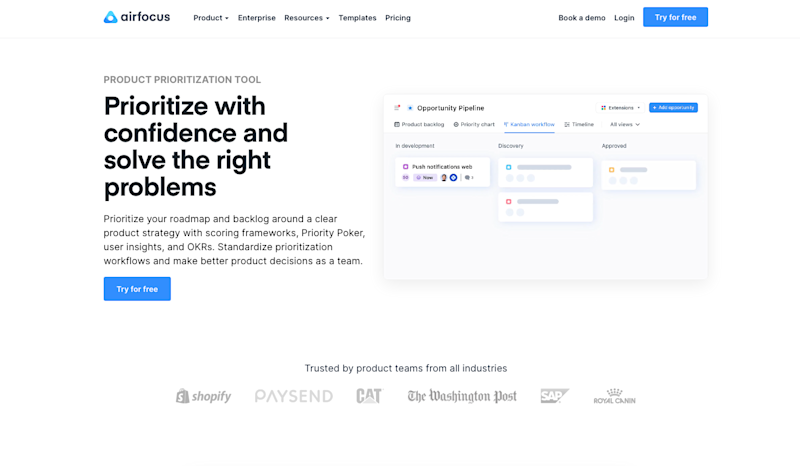
As we outlined above, airfocus promises smarter roadmap prioritization and offers a powerful way to prioritize tasks and build more effective roadmaps.
This software automatically calculates priorities and sets them out visually, helping teams and managers to make better decisions.
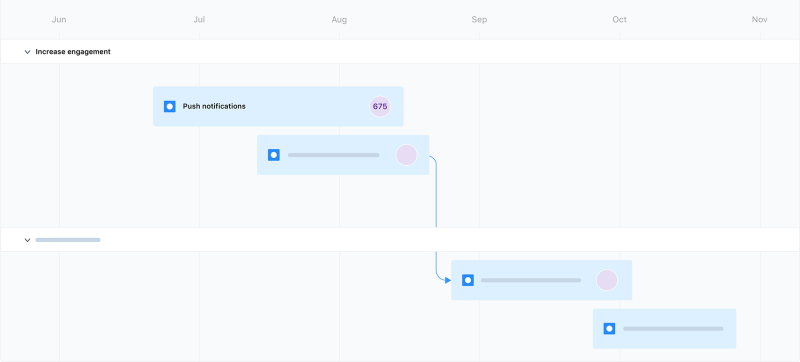
That’s why we think airfocus offers a comprehensive business solution — one that helps prioritize strategy, align teams with organizational vision, and get projects done more efficiently and effectively.
Starting price: Subscriptions start at $19 per month for individuals and $69 per month for teams when billed annually.
Free version: No.
Integrations: airfocus integrates with Trello, Asana, Zapier, MS Planner, GitHub, and Jira.
Dedicated prioritization tools: Yes. airfocus does have a dedicated product prioritization tool, and it’s a core feature of the product. You can pick from a range of prioritization templates built on the most effective decision-making techniques and take advantage of the prioritization wizard to set up a workspace and roadmap in minutes.
What’s more, the intuitive rating system accurately calculates your priorities. At the same time, prioritization scores help you evaluate how your features or products are doing against strategic factors, guiding you to a more focused and effective roadmap.
Another exciting feature is the Priority Poker tool, which democratizes prioritization and decision making — allowing team members of all experience levels to actively contribute to rating decisions and priorities.

Templates: airfocus provides a full range of product management templates built on best practices in decision-making and roadmapping for various projects, sectors, and processes. All templates are fully editable and adjustable and are aimed at being the springboard for teams’ inspiration.
Dependencies: Dependencies are an important part of every project, and airfocus allows you to create multiple relationships between items on a roadmap, to avoid risk and improve collaboration and planning. airfocus supports two types of dependency: Blocked By and Blocks.
Enterprise solution: airfocus offers an Enterprise solution for scaling teams who need advanced security and support. The Enterprise solution offers all the functionality of the Team plan, with Enterprise terms, priority support, and SAML SSO. Custom prices are available on request.
Shareable timeline: Yes, all priorities and roadmaps are shareable with a single click.
Shareable boards: airfocus has unlimited free viewer accounts, making it easy for all stakeholders to view and feedback on priorities.
Zapier integrations: Yes, airfocus fully integrates with Zapier.
airfocus AI Assist: It’s clear that AI technology is set to revolutionize the way we work, and at airfocus we weren’t about to be left behind. That’s why we developed airfocus AI Assist. We built AI Assist to help product managers save time and use the latest technology to enhance their product development workflow.
With easy to use slash commands you can use AI Assist to help you plan and roadmap your products quickly and efficiently. Try commands like:
Generate a product roadmap
Draft a product vision statement
Conduct market and competitor research to inform product strategy and product roadmap
We could go on, but it’s more fun to try out AI Assist for yourself! And be sure to take a look at our list of helpful prompt ideas to get you started.
Zoho — great customization, but missing a library of templates
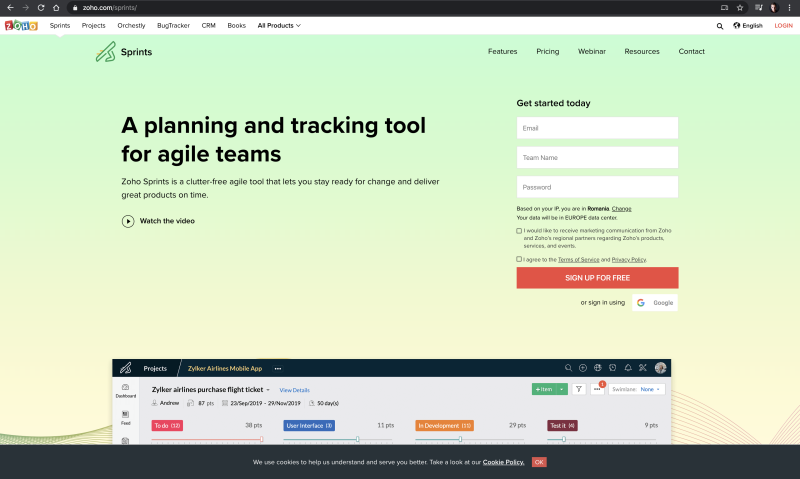
Zoho aims to help businesses run more effectively and transform the way organizations work. Zoho Sprints is their product roadmap tool, created for agile teams to help reduce clutter and deliver great products on time. Zoho Sprints is an incredibly flexible and adaptable tool, best used by teams working within a Scrum agile framework.
Starting price: Zoho Sprints starts at $10 per month for twelve users, billed annually. Their pricing goes up on a sliding scale based on the number of users.
Free version: Zoho offers a free version of their Sprints tool for five users, allowing five projects and 500MB of storage space.
Integrations: Zoho integrates with its suite of software, as well as other third-party apps, including Office 365, Github, Microsoft Teams, and Bitbucket.
Dedicated prioritization tools: No. Zoho Sprints does not offer a dedicated prioritization tool.
Templates: Zoho Sprints allows you to reuse previous projects as templates or create your own project templates to work on for recurring projects in the future. However, it does not have a specific library of templates, which could be a drawback for some.
Dependencies: Zoho Sprints is exceptionally customizable and allows you to use custom fields to give context and depth to every element of the project, including acceptance criteria and dependencies.
Enterprise solution: Zoho Sprints does not have a specific Enterprise solution. Their pricing structure goes up to organizations with 500 users ($1,268.60 per month). Organizations with more than 500 users can get custom prices on request.
Shareable boards: Zoho Sprints incorporates meetings as part of the platform and has a dedicated ‘Feeds’ feature to keep distributed teams together and provide a space for collaboration and quick feedback.
Zapier integrations: Zoho Sprints integrates fully with Zapier.
Favro — view multiple boards at once to boost collaboration
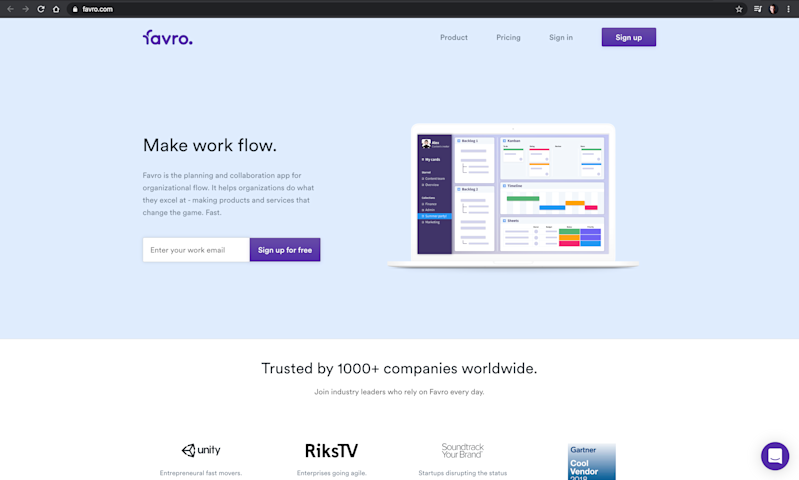
Favro is a planning and collaboration app designed to improve workflow across a business, helping build and ship quality products fast. It provides a flexible platform that works across different teams and ensures great collaboration without the need for rigorous, inflexible plans. Favro was developed with planning and collaboration in mind, and its flexibility allows streamlined use across organizations.
Starting price: Favro’s Lite plan starts at $10.20 per month for two users. Their Standard plan starts at $13.60 a month for two users. Then, pricing increases on a sliding scale based on the number of users, up to 100.
Free version: Favro offers a 14 day free trial for all of their plans.
Integrations: Favro integrates seamlessly with various third-party platforms, including Github, Slack, and Google Drive.
Dedicated prioritization tools: No. Favro does not offer dedicated prioritization tools.
Templates: Favro allows you to create templates from any card, backlog, board or collection, to speed up future work and repeat processes that work. The platform does not come with a library of prepared roadmap templates.
Dependencies: Favro’s ‘Attach Favro cards, boards, and backlogs’ function allows users to create two-way dynamic links between cards, boards, and backlogs, to manage dependencies.
Enterprise solution: Favro’s Enterprise solution starts at $25.50 per month for two users and increases on a sliding scale depending on the number of users. Enterprise offers enhanced support, SAML SSO, and 10,000 API calls per hour.
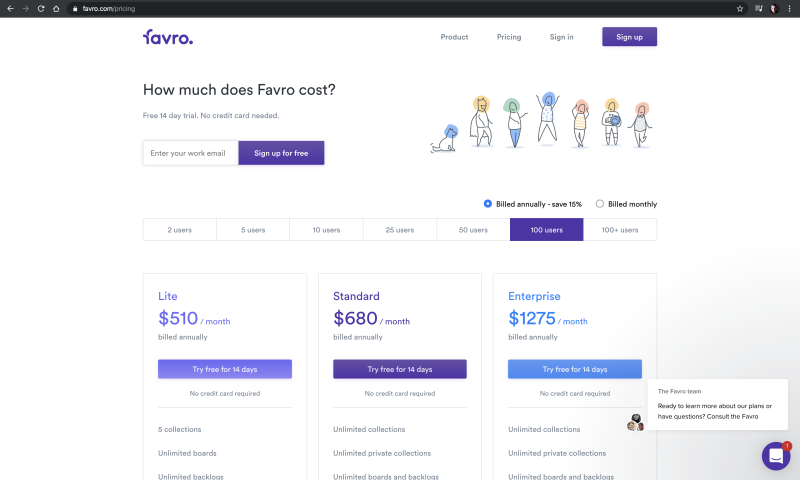
Shareable boards: Favro is fully shareable with users, teams, and stakeholders, and its boards are flexible so that specific audiences can get the relevant information easily. Cards make collaboration simple, and boards and cards can exist in multiple places at the same time to allow oversight while work continues.
Zapier integrations: Favro integrates fully with Zapier.
Trello — an impressive menu of power-ups and integrations
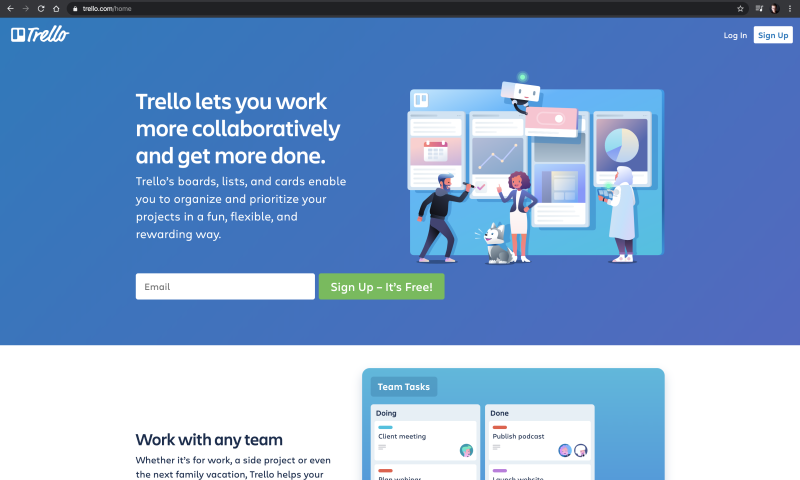
Trello is a comprehensive project management tool, which encourages collaborative working and helps organize projects and prioritize workflows. It offers a wide range of options for a huge variety of tasks, projects, and plans and can be customized to provide specific product roadmaps. Despite its numerous features, Trello manages to be super-lightweight, as the vast majority of its functions are performed or enhanced by integrations with apps and third-party software.
Starting price: Trello’s priced plan starts at $9.99 per user per month.
Free version: Trello offers a free version with reduced support, 10 team boards, no templates, and access to simple automation.
Integrations: Trello integrates fully with a wide range of third-party software and apps, including Dropbox, Slack, Gitlab, and Google Drive.
Dedicated prioritization tools: Trello itself does not offer dedicated prioritization tools, but it offers various power-ups (integrations) that allow cards to be prioritized, like Screenful and airfocus.
Templates: Trello offers a huge variety of templates, with blueprints for teams from every sector and for every type of project, from holiday planning to software development. All templates are fully customizable and easy to use.
Dependencies: Trello offers powerful built-in workflow automation that can take care of repetitive tasks like dependencies. It also integrates with the Hello Epic power-up, which is designed to make managing dependencies easier.
Enterprise solution: Trello’s Enterprise solution for teams with more than 100 users starts at $20.83 per user per month and increases on a sliding scale depending on the number of users.
Shareable boards: Trello is fully shareable via email link. Boards can be made public or private at the click of a button.
Zapier integrations: Trello is fully integratable with Zapier.
Jira - The #1 software development tool used by agile teams
Jira is a powerful tool for product roadmapping because it allows teams to create and manage a visual representation of their product strategy. With Jira, teams can easily track progress, prioritize features, and communicate updates to stakeholders. Its flexibility and integration with other tools make it great for product managers looking to streamline their product development process.
Starting price: Standard plan starts at $7.75 per user per month.
Free version: Yes, free for up to 10 users.
Integrations: There are over 3000 Jira apps that integrate with almost any piece of software you might need.
Dedicated prioritization tools: Jira doesn’t have dedicated prioritization tools, but there are plenty of plug-ins and apps that can help.
Templates: Jira offers lots of templates, including roadmaps.
Dependencies: Jira can help you easily track dependencies across teams, projects, and initiatives.
Enterprise solution: Yes, Jira Align offers enterprise-level features.
Shareable boards: Jira boards can be shared internally and externally, though external sharing may require an additional app or third-party program.
Shareable timeline: Jira allows you to easily share your roadmap with different filters to show your stakeholders what matters to them without the jargon attached.
Zapier integrations: Jira does offer Zapier integration, though it's not well reviewed.
Monday.com - A platform built for a new way of working
Monday.com is a versatile platform that offers numerous features to help product managers with roadmapping. Its intuitive interface and customizable templates make it easy for teams to collaborate and plan their product development roadmap. With powerful integrations and automation tools, Monday.com streamlines the process of tracking progress, managing dependencies, and communicating updates to stakeholders, making it an ideal solution for product managers looking to optimize their roadmapping process.
Starting price: Plans start with their basic package, priced at $10 per user per month.
Free version: Yes, for up to 2 users.
Integrations: Monday.com offers all the typical integrations you would expect to see with roadmapping software.
Dedicated prioritization tools: While Monday.com doesn’t offer dedicated prioritization tools, they offer plenty of templates for prioritization.
Templates: Yes, Monday.com offers templates for product roadmaps, prioritization, and more.
Dependencies: You can easily add dependencies to your roadmap to increase visualization and awareness.
Enterprise solution: Monday.com offers an enterprise-level package for those needing all the platform has to offer and a little more.
Shareable boards: Boards can be publicly shared with ease.
Shareable timeline: Yes, though it is locked behind higher-priced plans.
Zapier integrations: Yes.
Conclusion: Which is the best product roadmap software?

In truth, all of these software options offer different functions and features and have specific benefits for particular teams.
Yes, Trello is a comprehensive project management tool, and its power-ups can help transform pretty much any business or project that you throw at it.
Zoho is designed to be perfect for agile development teams and is great for anyone working within a Scrum framework in particular.
In comparison, Favro is incredibly flexible and adaptable and offers great cross-organization working. Jira proved itself in project management, but could be difficult for non tech-savvy team members, and Monday is helpful for roadmaps, until you run into paywalls.
When it comes down to it, for serious product roadmap software, airfocus comes out on top.

Its dedicated prioritization tools and priority poker ‘game’ add a new level to roadmapping, making putting together a strategic plan for your project easier than ever before. airfocus roadmaps end up being more effective and more intuitive, and managing dependencies is made simple without the need for programming or extra integrations.
For product roadmaps, airfocus offers the best, most user-friendly option and will make a huge difference to your team’s project planning.
If you want smart roadmap prioritization, give airfocus a try and create your first product roadmap using this template today.

Malte Scholz
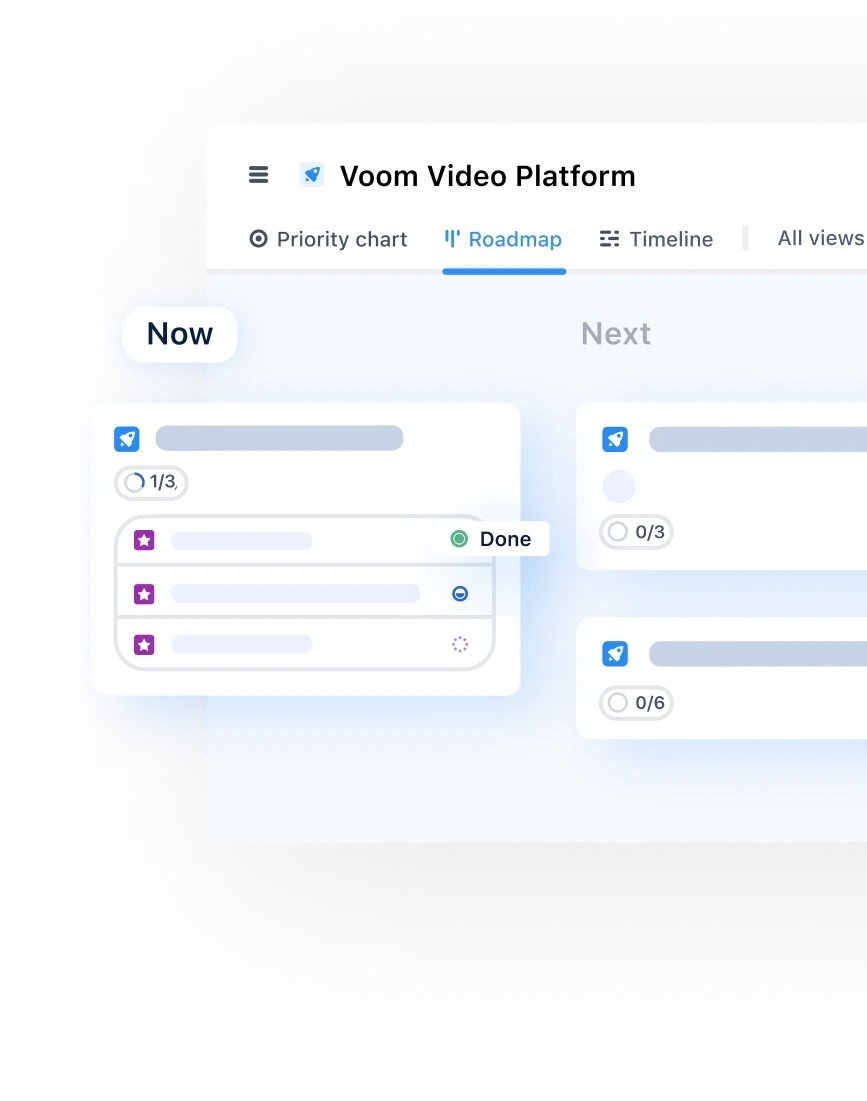
Read also



Build great roadmaps
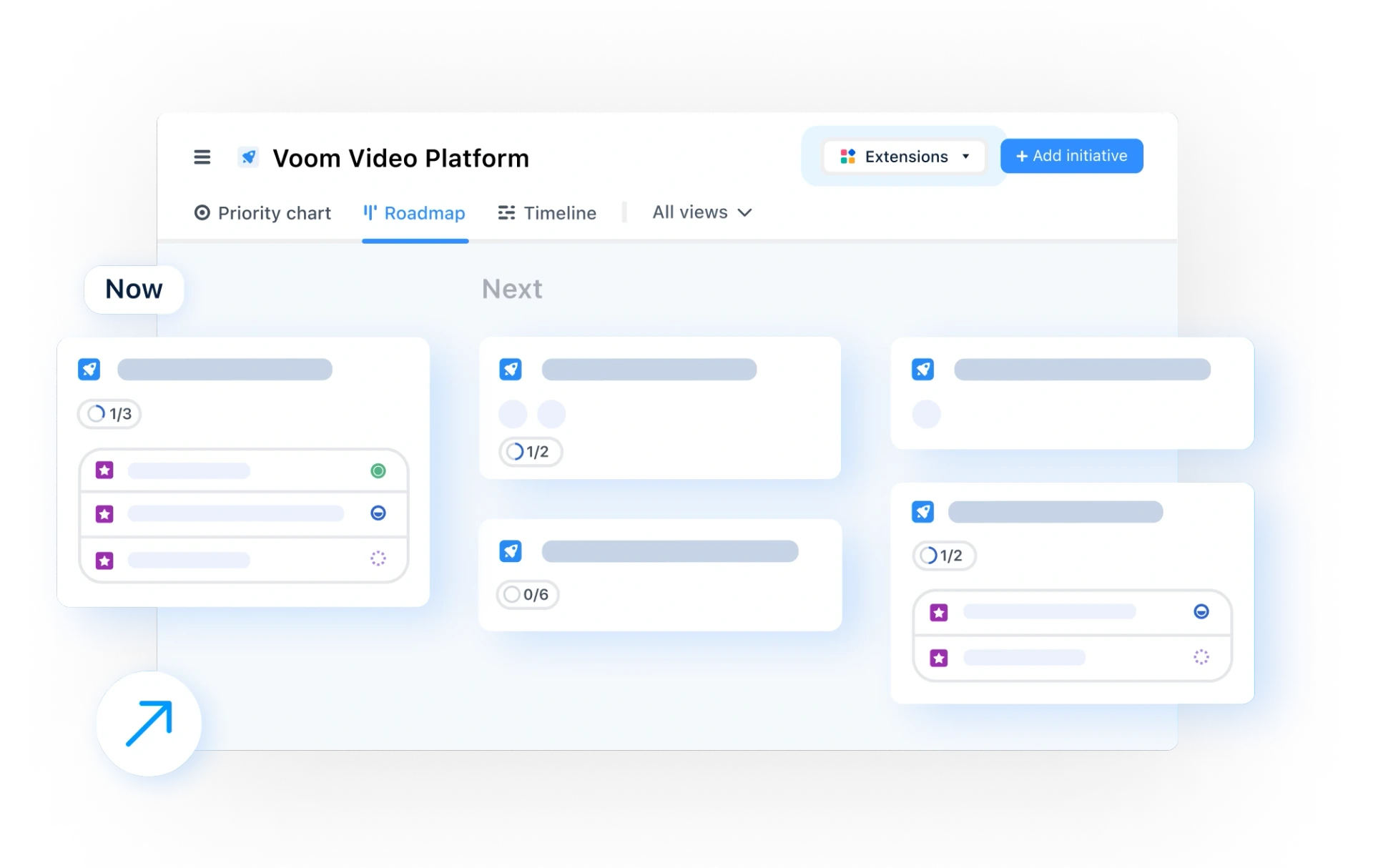
Experience the new way of doing product management
